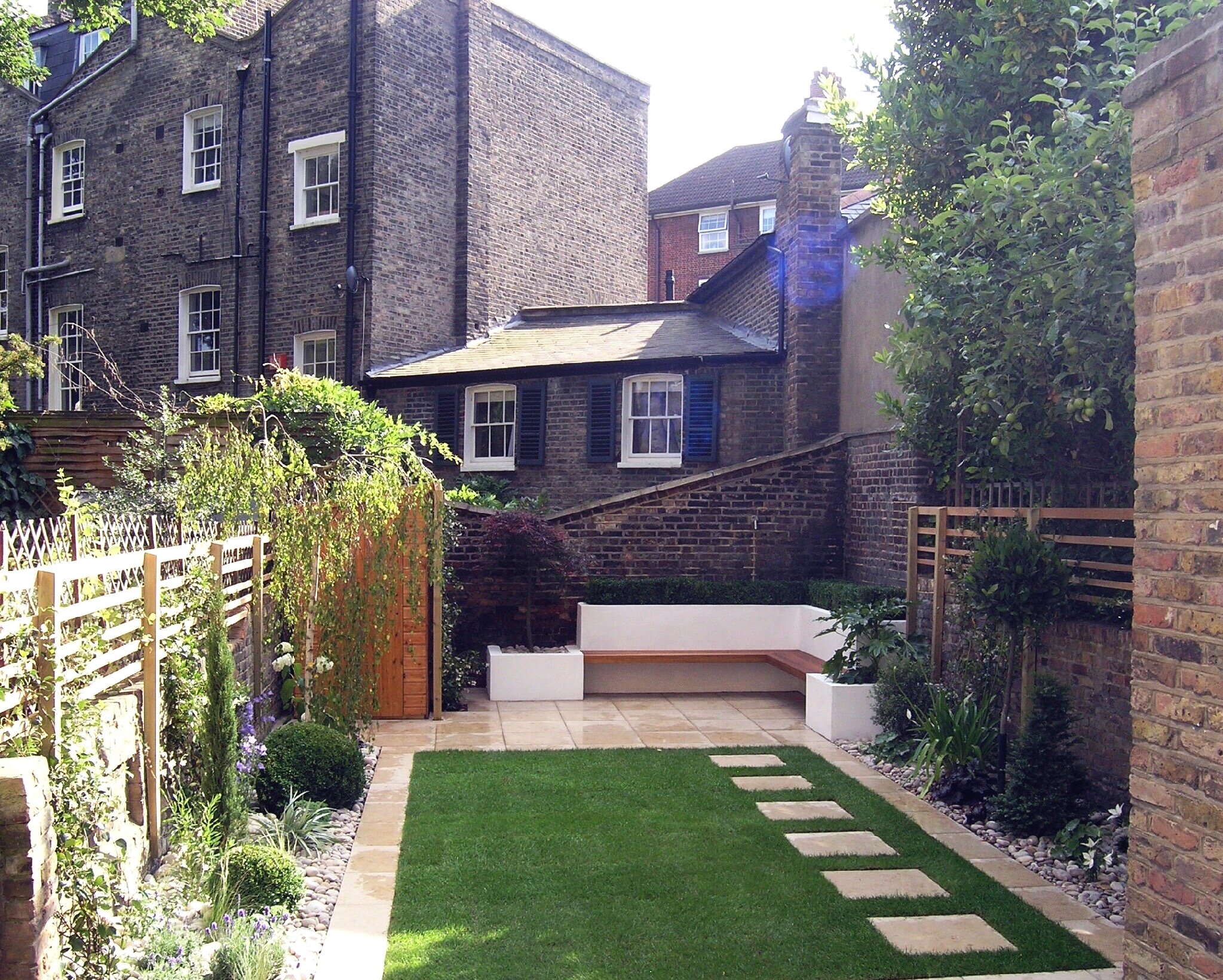Creating contemporary garden designs
Harriet Stigner
The arrival of spring is a natural time to look at our gardens with fresh eyes.
We were recently asked to contribute to an article on ‘how to make your garden feel modern’. Here are some of our tops tips for updating your garden design, along with those that Gardening Etc quoted from us.
A beautiful contemporary garden design in Camden Town, North London
Introducing contemporary elements with period architecture
When modernising your garden, some simple tips can help you to ensure that you marry the design with its surrounding architecture. Using contemporary materials sometimes jars with period properties, but the geometry of your design and the use of structural planting can complement neighbouring features and create a cohesive balance of old and new.
The L-shaped Iroko bench and rendered planters in this Canonbury garden design in Islington, complement the geometry of the surrounding architecture.
When updating gardens for period properties, using reclaimed materials nearer to the house and gradually introducing more modern elements the further you travel into the garden can work especially well.
In recent years we are finding it particularly useful to apply the same principle in reverse, creating cohesion in properties with a modern extension.
By dividing contemporary and reclaimed materials in this Tufnell Park garden design in Islington, we’ve mirrored the striking contrast between old and new achieved by the architects Robert Rhodes. The same ceramic tiles that were chosen for the interior room extend the living space outdoors. Steps with tiered planting lead to the original garden level, marking a transition into reclaimed materials such as York stone and stock bricks.
If you’d like to modernise and draw attention away from older boundary walls, carefully placed trellis can draw the eye into the space and synchronise irregular levels.
We used red cedar horizontal trellis to draw the eye and detract from the varying heights of the boundary walls in this small courtyard garden design in Islington.
Modernising on a budget
Render and painting is a great option to achieve a bright smooth finish on old walls, as long as they are in sound condition. A future makeover can quickly bring your garden up to date through repainting, together with sanding and oiling hardwood decks and benches. Subtle colour changes are very effective for this, for example, recent trends have moved away from beige-based to greyer whites.
Introducing a bold colour that speaks to you and your emerging tastes can also give your garden an instant refresh. Affordable elements like painted small square trellis can be used to introduce new colours and shapes to your design.
Small square trellis painted in a colour that compliments the rendered wall adds to the vitality of this Canonbury garden design in Islington. North London.
A polished canvas
Replacing patchy and muddy areas will give your garden a fresh finish and help other elements you introduce (such as sculptures, new furniture and planters) to stand out against a clean background. We always prefer a living lawn, but if the conditions and light levels are not suitable to use turf, artificial lawn on a permeable base will give you a beautiful low maintenance alternative.
A verdant lawn is the perfect canvas to help other elements of your garden to shine.
Planting
Certain plants carry modern connotations, including potted succulents (these look particularly good in concrete and stone planters).
Being aware of our changing climate naturally steers you away from traditional garden schemes towards drought tolerant species that are better able to withstand future climates. These might include grasses, sedums, olives, creeping thyme, rosemary, and Erigeron. Exotic looking plants like Dicksonias don’t even have an effective root system and can be planted into concrete. These plants all carry the added benefit of being very low maintenance.
Uplit Phyllostachys aurea and Dicksonia compliment this contemporary mezzanine garden design in Islington.
Fire features
Fire features can make a garden look very contemporary and give you somewhere warm to congregate. In fact, even when they’re unlit, they give the impression of warmth and make your garden feel like a welcoming, modern space. By naturally fostering a ‘living space’ in your garden, fireplaces and features encourage us to use gardens in a modern way as sociable outdoor rooms.
The tall rear boundary wall in this Canonbury garden design in Islington N1 gave us the perfect opportunity to create an outdoor chimney breast for a real log fire.
Enjoy trends, but be wary of them
Like all fashion, garden trends can date quickly too. To make your investments worthwhile, we’d always recommend that you focus on getting the key elements of your garden design, shape and journey right first, then you can gradually replace different features and materials as and when you feel that they require a refresh.







